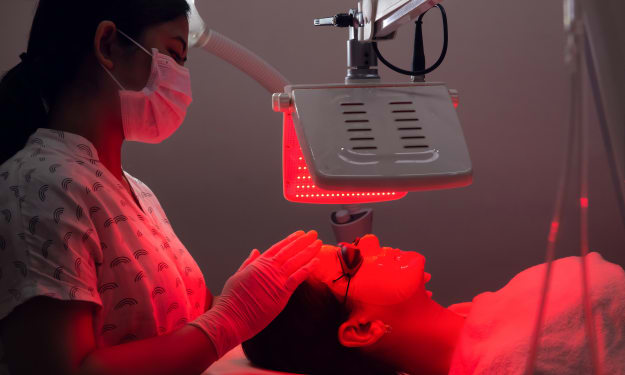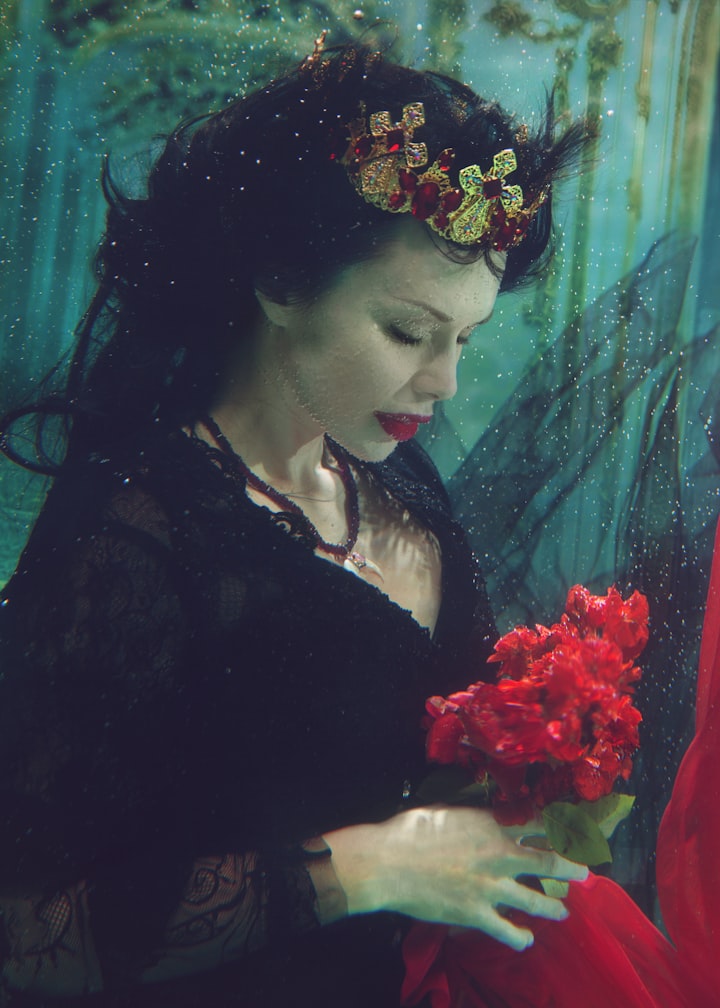Regrow Thinning Hair Using Red Light Therapy
Photobiomodulation light treatment may offer a solution.

Thinning and hair loss affects millions of men and women. Red Light Therapy is scientifically proven and FDA approved for regrowing hair. The predominant wavelength I have seen used in studies is around 650 nm.
Originally this research was performed only using low-level laser therapy (LLLT). However, today various manufacturers offer hair restoring skull caps fitted with dozens of laser diodes and standard LEDs.
The advantages of this therapy are that it applies to both men and women of all races, and there aren’t any reported adverse side effects.
One of the first effects observed by Mester in 1968 was the regrowth of hair around a wound he treated with laser light. The wavelength of light used by Mester in his original research was 694nm.
As discussed in my other red light therapy articles, the light stimulates cells in the same manner across the body. In this case, the light directed toward the scalp stimulates the cells in the hair follicles to grow. The exact process by which this happens is not known. One theory is that light acts as a vasodilator and allows more blood to the hair follicle. This is believed to be how, at least in part, how the over the counter drug Minoxidil works to restore hair.
Modern hair regrowth devices use both standard LEDs and Laser LEDs. The laser LEDs provide a pinpoint light source, and the standard LED will give a diffuse light source. The combination of radiance is believed to optimize the stimulation of the hair follicles.
Preliminary studies with mice illustrated the biphasic effect of photobiomodulation. When mice were treated with 1J/cm², they showed significant hair regrowth (above baseline) in three weeks. However, when the light dosage was increased to 5J/cm², hair growth was significantly decreased (below baseline) in hair growth¹.
The light dosages illustrate the biphasic nature of photobiomodulation therapy, where too much light is worse than too little. For more information, please read my article on Red Light Therapy Dosages.
Getting Hair To Regrow
This study used two wavelengths of light, 655 nm, and 780 nm. The light illuminated the scalp for 10 minutes once a day. After 14 weeks, the results were an increase in density to 145.1/cm2 vs. 137.3/cm2 pre-treatment.
Another study used a single light wavelength of 655 nm but used a combination of laser diodes and standard LEDs. Forty-two women completed the study. There were 24 women in the active group and 18 women in the sham group. The researchers counted the hair in a 2.85cm² area of the scalp. The baseline count in the sham group was 228. In the active group, the baseline count was 209. After 16 weeks of treatments, which consisted of one 25 minute treatment every other day, the hair count results for the sham group went from 228 to 252. For the active group, the hair count went from 209 to 310².
That is an increase of 30% more hair for the actively treated group.
Evidence Suggests
Most clinical studies with hair regrowth used low-power lasers. However, evidence suggests that LEDs will work just as well. Modern LED caps use a combination of LED laser diodes and standard LEDs.
Difference Between FDA Approved and FDA Cleared
Before I discuss light sources and caps, I need to clear up the confusion between FDA Approved and FDA Cleared. The distinction between FDA Approval and FDA Clearance is, in my opinion, predominantly a legal difference.
An FDA approval means that the FDA has determined that the product’s benefits outweigh the known risks for its intended use. To prove the benefits outweigh the risks, the manufacturer is required to submit a premarket approval (PMA) application and clinical results that demonstrate the device’s efficacy in the treatment of its intended use (which in this specific case is hair loss).
An FDA Cleared product means that the manufacturer has demonstrated to the FDA that their product is “substantially equivalent” to a similar device that already has received FDA approval. Previous cleared and approved products are called a predicate.
Is FDA Clearance as good as FDA approval? Unfortunately, no. The cleared device is not required to submit clinical study results that prove the device’s efficacy. However, it’s pretty darn close because the FDA has determined the cleared device is “substantially equivalent” to an FDA-approved device.
Light Sources
Most RLT units, both table, and wall units, should work. It would help if you moved your head close to the unit to illuminate your scalp with the red light. Treatment would consist of 10–15 minutes every other day. Results should become apparent in 16–24 weeks.
So if you already own an RLT unit, I would recommend trying that for a few months before investing in new RLT equipment. The exception to that rule is convenience.
Custom light sources for hair regrowth are caps and helmets you wear for 15 minutes every other day. Several manufacturers had gotten FDA clearance for hair regrowth devices. One of the more reasonably priced units are from Irestore at https://www.irestorelaser.com/
Hair max is another skull cap RLT manufacturer, https://hairmax.com/
FDA Cleared
When purchasing, LED caps with FDA clearance will cost about 3X more than a similar LED cap without FDA clearance.
If you do not need an FDA-cleared device, you can find a few inexpensive imports from China available on Amazon for under $200.00. Most FDA-cleared caps use a LED light wavelength of 655 nm. However, a few hair regrowth studies used a combination of red (655 nm) and infrared light ( 780 nm). Therefore, you may want to look for this combined light option.
Throwing on a LED cap for 15 minutes every other day is more manageable than standing close to a LED wall unit to illuminate your scalp.
Supercharging Your Hair Regrowth with Minoxidil
I mentioned before that Minoxidil might work on the same vasodilation pathways as photobiomodulation. Therefore, researchers tested Minoxidil, vs. Photobiomodulation, vs. a combination of Minoxidil and Red Light Therapy. The combination therapy of Minoxidil and RLT appears to have doubled the hair regrowth in a two-month time frame. This particular study was performed using women with Female pattern hair loss (FPHL), but I would venture to believe the results will hold for men as well³.
Minoxidil may be purchased without a prescription at your local drug store.
Off Label Use — Treatment for Neurological Diseases
While these LED caps are marketed for hair regrowth, there is evidence that photobiomodulation may be an effective treatment for neurological disorders like dementia, Alzheimer’s disease, and Parkinson’s disease⁴.
Build or Buy
It seems almost too easy to build a cap unit. To this end, I have seen several DIY’ers grab a couple of feet of monochromatic LED strip lights and use them to line the inside of a helmet to create their own makeshift LED helmet.
While you can purchase monochromatic LED strip lights from Amazon, you can’t choose light wavelength easily, or the product description doesn’t have wavelength information.
Going to an online electronics supply like Digi-key will provide more information and better options. For example, this LED strip has a high density of LEDs per inch and a light wavelength of 620–630 nm.
With a form and a little cutting and soldering, these led strips may be fashioned into an interior lining for a cap or hat.
More Than Hair Regrowth
Another advantage of building over buying is utilizing photobiomodulation light to prevent or treat dementia and Alzheimers. Research in this area usually combines the red light used for regrowth with IR light at 850 nm. The 850 nm wavelength is not associated, from what I’ve read so far, with regrowing hair.
There is phenomenal research highlighting how RLT works as a course of treatment for these neurological disorders with positive results. Some of the studies look at pulsing the light at 40hz.
Buying an expensive LED cap may prevent someone from hacking the device for it to serve double duty.
Hacking is not an issue with the DIY building. I am writing a book on RLT, where I will have instructions to build a few DIY photobiomodulation devices.
More Information on Red Light Therapy and Photobiomodulation
I recently published a book on Red Light Therapy titled “Living Younger Longer Using Red Light Therapy.” The book is available on Amazon.com, I have ePub, PDF, and print books available from my website at :
https://john-iovine.com/living-younger-longer.html

Disclaimer
The content and information contained in this article are for informational purposes only. The information provided in this article is not and must not be taken as an alternative to any advice by a doctor, physician, or medical professional.
The author, John Iovine, has narrated his research experiences in this article by observing and evaluating facts and figures. The reliance on the facts and figures has been done in good faith and believed to be reliable according to the author’s best knowledge. The sources of referenced information could change or be updated in the future. The author cannot guarantee the validity and accuracy of the sources, which may change, be modified, updated, or removed in the future, and thus, disclaims himself from any such changes, modifications, updates, and removals.
References
1 https://www.ncbi.nlm.nih.gov/pmc/articles/PMC3944668/
2 https://pubmed.ncbi.nlm.nih.gov/25124964/
3 https://pubmed.ncbi.nlm.nih.gov/28489273/
4 https://pubmed.ncbi.nlm.nih.gov/31647776/
About the Creator
John Iovine
Science writer





Comments
There are no comments for this story
Be the first to respond and start the conversation.